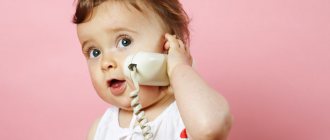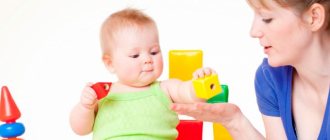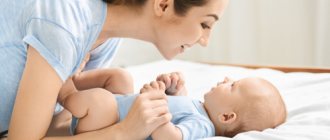Dyslalia: definition, causes, work plan. “The child is burring and does not speak the sounds R, L, S, Sh...”
At the very beginning of work, the doctor draws up a plan for solving the following tasks:
— The speech therapist must establish a friendly relationship with the patient, win him over and adapt to the environment of the speech therapy room, arouse his interest in the classes; — Formation of the child’s awareness of activities; — Develop memory and attention; — Teach phoneme recognition; — Form motor speech skills.
The preparatory stage is divided into the following areas:
— Formation of phonemic processes; — Formation of articulatory motor skills; — Formation of fine motor skills of the hands; - Strengthen reference sounds.
Development of phonemic processes. Before proceeding with the development of phonemic processes, it is necessary to form in the patient an idea of the sound that he needs to deliver. It is necessary to teach the child to distinguish specific sounds from similar sounds.
The features of this task are: 1. First, you need to form the child’s conscious involvement in the treatment process; 2. The development of phoneme perception should be carried out first on the material of words. 3. Help the patient distinguish between heard sounds in speech
Considering that the articulatory structure of a certain sound is not initially formed, it is impossible to work on its difference. However, this type of treatment is necessary at the preparatory stage, so it should be carried out using the example of intact pairs of sounds in words. To learn to distinguish a certain sound from its substitute, it is necessary to pronounce it in perception. It is worth prohibiting the reproduction of speech material with a defective sound until the phoneme is delivered. To do this, it is necessary to study the sound composition of words. For this purpose, patients are given tasks to determine the place of a sound in a word. It is important to consider that such constructions should be carried out only on the material of vowels and simple consonants.
From this it follows that the development of phonemic processes at the preparatory stage is carried out in the following directions: 1. Perception - discrimination and perception of sounds by ear; 2. Pronunciation – practicing speech using preserved sounds.
Development of articulatory motor skills
Since, with any form of dyslalia, the pronunciation of sounds is impaired, it is necessary to establish the correct articulatory structure or form the missing articulatory movements. There are no gross motor disorders, which means muscle tone is fine. However, the patient has not formed only individual voluntary articulatory movements. In this case, the development of motor skills should be voluntary, conscious and aimed at the development of new speech patterns. For this purpose, the speech therapist forms the missing articulatory patterns according to visual imitation. In front of a mirror, the child is shown the necessary posture of the organs of articulation. If difficulties arise, the speech therapist helps the patient using his fingers or a spatula. If the child still cannot physically imitate the doctor, then articulation gymnastics is performed.
The goals of articulatory gymnastics are: 1. Formation of kinesthetic sensations from the movements of the speech apparatus; 2. Creating an articulatory pose.
Articulatory gymnastics develops and shapes the mobility of the articulatory organs. For this, speech therapists use in their practice: exercises for the lips, tongue, lower jaw, soft palate, and so on. Speech therapy articulation gymnastics consists of static and dynamic exercises.
Static exercises develop the ability to create and maintain the desired articulatory position. And dynamic training develops operational switchability, dynamism and smoothness of movements.
When working with the tongue, the “Needle” exercise is used, for which you must follow the instructions: - Open your mouth slightly - Stick your tongue forward - Hold, counting to yourself to 10
Another dynamic exercise is the “Clock” exercise: the tongue should alternately touch the left and right corners of the mouth, counting one or two. The above activities must be performed on command so that they are conscious.
While working with gymnastics, the speech therapist is required to develop the following qualities: 1. Precision in performing the exercises. The quality is determined by the location of the shape of the speech organ. 2. Structured and smooth movements. The exercise should be performed without unnecessary movements and jolts 3. Maintain the pace. Initially, the task must be performed slowly, and then faster. The patient must learn to independently change the tempo of articulatory movements 4. Consolidate the result. The articulatory pose must be maintained for up to 15 seconds 5. Switchability. The change of movements should occur smoothly, but quickly 6. Movements of organs are symmetrical to the right and left sides
When conducting articulatory gymnastics, the following requirements must be observed: 1. Conduct classes with static and dynamic exercises 2. Classes with a combination of tongue and lips 3. The duration of classes should be short so as not to overtire the child 4. It is necessary to develop self-analysis of kinesthetic sensations with sound 5. Gymnastics should be carried out in a playful way 6. Tasks are performed in a sitting position so that the arms and muscles are relaxed 7. Articulation exercises are gradually made more difficult 8. Classes are conducted in front of a mirror
To determine the content of articulation exercises, it is necessary: 1. Parse the generalized sound into movements 2. Determine incorrect pronunciation 3. Form the desired structure through articulation exercises 4. Work with certain parts of the structure using differentiated articulatory gymnastics. Once individual movements have been worked out, they need to be combined. Next, the exercises include an air stream and working on the vocal folds.
In order to eliminate labial-dental pronunciation, use the following exercises for the tongue: 1. Hold the tongue on the lower lip and hold it for 5 seconds 2. Hug the upper lip with the tongue and hold this position 3. Hug the upper lip with the tongue and close the mouth with the tongue in the form of a “spoon” - close your mouth after this
Exercises for the lips: 1. Expose the lower jaw, lowering the lower lip and hold for 5 seconds 2. Hold the lips with a tube for 5 seconds 3. Make the lips a tube, and then smile. Repeat, alternating the position of your lips for a count of one or two.
As soon as the exercises are completed clearly and correctly, the speech therapist invites the child to make two articulation positions simultaneously and breathe or blow to hear the sound “sh”. If the sound still does not sound clear, work on clarifying it continues with the help of additional articulatory positions.
Next, it is important to form an air stream, for this follow the instructions: 1. Inflate your cheeks and hold the air in them 2. Alternately transfer air from one cheek to another 3. Retract your cheeks
Development of fine motor skills of the hands Usually, with dyslalia, the movements of the hands are impaired. To develop the functions of the hands, mosaics, lacing, fastening buttons, drawing, working with scissors, plasticine, working with small objects, and so on are used in practice.
Practicing reference sounds With dyslalia, vowels and consonants are preserved. If the articulation of consonants and vowels is incorrect, then the necessary sounds are set, and then they are used with patterns of complex sounds. By the way, the sounds “f” and “v” are the reference sounds for whistling and hissing phonemes. The shape of their formation is slotted; their reproduction requires a long, definitely directed air stream. The sounds “f” and “v” are among the easiest to pronounce. If the patient masters labial-dental sounds, then the correct pronunciation of whistling and hissing sounds automatically develops. If these phonemes are inaccurate, then the reason for this is weak articulatory muscles of the lips. In this case, it is necessary to form an air stream, which is also necessary for reproducing slot sounds. If a child cannot hold the tip of the tongue behind the upper teeth and pronounces them between the teeth, then when pronouncing the phonemes “r”, “l” or hissing sounds, the tongue will also be between the teeth. If the tip of the patient's tongue cannot be held between the teeth, whistling sounds will be suffered. By working on the articulation of the “t” sound, the correct structure of the “s” sound is formed. And if you connect the front part of the back of the tongue with the upper incisors, you get the sound “ts”. When working with the sound “s”, the doctor achieves a targeted air stream that moves along the middle of the tongue. Accordingly, when practicing reference sounds, the motor and auditory parts of speech develop. Thanks to this, the analysis and synthesis of word combinations is formed for the rapid automation of disturbed sound.
Causes of speech impairment
Organic and mechanical dyslalia develops under the influence of a physical defect in the articulatory apparatus, which prevents the correct pronunciation of sounds.
In most cases, this diagnosis is given to those children who have problems in the structure of the speech apparatus:
- cleft of the hard palate - “cleft palate”;
- cleft of the upper jaw - “cleft lip”;
- malocclusion - progenia or prognathia;
- absence of teeth, their incorrect location, distances between teeth;
- short hypoglossal ligament (“frenulum”);
- tongue that is too large or too small (macro- and microglossia);
- abnormal structure of the maxillofacial bones;
- underdevelopment of the lower jaw.
To eliminate a speech defect in the presence of one of the possible pathological conditions, the patient needs comprehensive assistance from various specialists.
Causes of functional dyslalia:
- weakness of the child caused by somatic and infectious diseases;
- violation of phonetic perception;
- MMD, history of mental development delay;
- delayed speech development;
- unfavorable social environment: pedagogical neglect, close contact with speakers of incorrect speech, limited contacts with society.
Diagnosis of speech disorders
To identify defective sounds, the speech therapist asks the child to repeat the words after him or her to name what is shown in the picture. This material is selected in such a way that it covers all groups of sounds. Moreover, the sound must be in different positions: at the beginning, at the end, and in the middle of the word, soft and hard consonants are also taken into account.
Parents should prepare for the fact that the speech therapist may need information about the presence or absence of pathologies of pregnancy and childbirth. The specialist may prescribe additional examinations from other specialists (vision, hearing, mental development tests). When a child is diagnosed with hearing loss, in addition to a speech therapist, he will need the help of an otolaryngologist.
Diagnostics includes a number of phonemic tests, which are aimed at testing the ability to distinguish sounds that are close in pronunciation. In the mechanical form of the pathology, it is impossible to get rid of the defect in the pronunciation of certain sounds unless the source of their appearance is eliminated. Therefore, the treatment of dyslalia begins with this.
Symptoms of the disorder
An adult can easily notice deviations from the norm in the perception and reproduction of sounds by children, although in the practice of a speech therapist there are more often cases when parents do not notice all the deviations in their child’s pronunciation.
When replacing sounds, children do not distinguish similar phonemes by sound and replace one sound with another. Most often, symptoms manifest as tongue-tiedness. For example, a child confuses deaf and voiced consonants, soft and hard (tree - tree, paw - blooper). If the difference in articulation is insignificant, and the sounds are formed in the same place, for example: instead of [P], [L] or [D] may sound (fish - lyba), instead of C - CH (chicken - chipling), etc. .
Sometimes a child has difficulty choosing a sound, although he can pronounce it correctly in individual words (Shapka speaks, but makes mistakes kaSya in the word porridge), that is, the same sound is pronounced differently depending on the situation. In some cases, children pronounce the sounds of the Russian language in a way atypical for the language system - throat (French) [P], specific [Z], similar to the English the.
Substitutions and confusion of phonemes refer to phonemic defects, distortion of sounds - to phonetic types of pathology.







